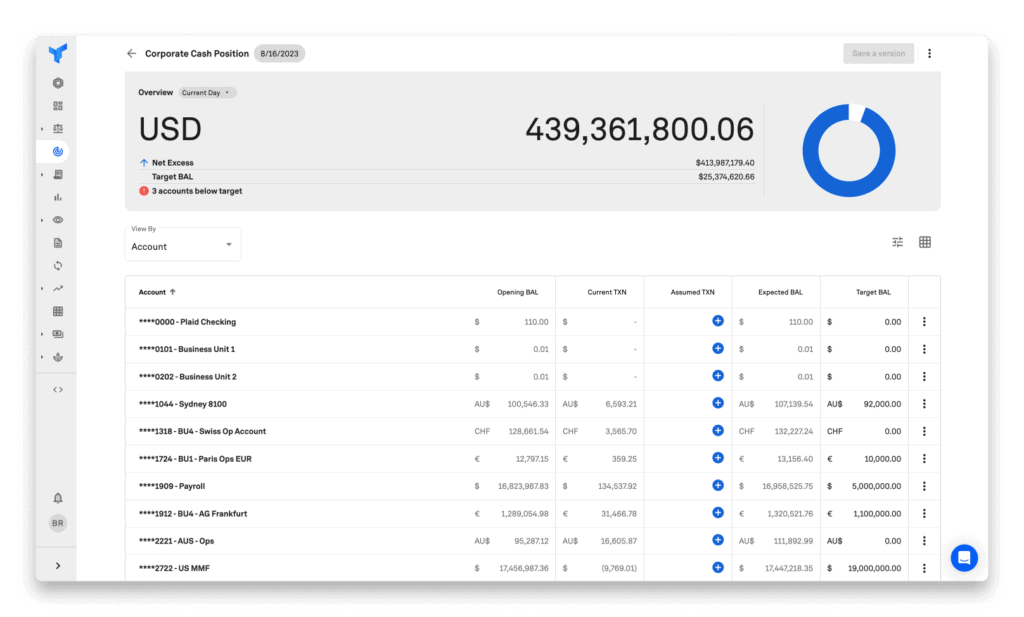Everything moves faster now. From the second a new piece of information is released, it’s spread to every corner of the internet, every social platform, every news outlet and every industry website. Not only does the actual information spread practically instantly, but so does the barrage of commentary, opinions and analysis.
For enterprise level finance executives and their teams, that means no time to spend weeks ruminating on the latest developments in their industry. This speed of information has created the need to act just as quickly to limit the impact of negative information, and maximize the benefits of the positive. The demand for faster analysis is reshaping enterprise liquidity management.
But it’s not just the speed at which events are happening, it seems to be also the magnitude of those events. The pandemic, record inflation, the fastest hikes in interest rates since the 1980s and mass volatility in stocks market all in the last two years alone. It’s enough to give even the most well prepared CFO whiplash.
It’s not looking like settling down any time soon either, with 67% of treasurers and a recent survey of 40 global economists expecting another rate hike from the Fed this year. With rates then expected to head back down in 2024, it’s clear that the roller coaster isn’t pulling into the station just yet.
That might all seem rather dark, but there’s good news. The landscape has become far more challenging for enterprise liquidity management, but the tools and technology that help have also improved dramatically.
Trying to handle all of these changing scenarios would simply not have been possible in the past. Manual spreadsheets and data entry, out of date liquidity positions and ad hoc forecasts meant that running an enterprise level business and managing the liquidity position, needed almost as much luck as it did skill and experience.
But now, treasurers and finance executives can use tech and advancements like open banking, AI, machine learning, APIs and cloud computing to instantly access real time data and ‘see the future.’ Or at least model and plan for as many different futures as they can imagine.

It’s Not 2015 Anymore
The relative stability of the low interest rate, stable growth environment of the 2010s was out the window, basically overnight, with the arrival of the pandemic. Since then finance teams have had to navigate their companies through events that have literally never happened in our lifetimes.
There’s been the rapid shift (and now slowly shifting back) to remote work, lockdowns and massive supply chain issues, subsequent inflation and the record high interest rates to combat it. Thrown in the mix have been a number of ‘normal’ crisis events like the 2022 market crash, the crypto hype and bust cycle, wars, banking collapses and struggles in the labor market.
It’s become abundantly clear that finance teams can’t set an annual (or even quarterly) forecast and forget about it until the next review. With the world moving at such a pace, the collection and analysis of data needs to happen quicker than ever.
It’s why digital transformation is happening now, and happening fast. Already, 78% of executives are already implementing AI in their business, and 71% of them say that advancing AI is a key priority.
Digital Transformation in Practice – Future Proofing Enterprise Liquidity Management Processes
It’s important to clarify that this goes beyond buzzwords. There are real, tangible ways in which this area of tech can improve the efficiency and capabilities for finance teams on a day to day basis. We’re all used to hearing terms like cloud computing and open APIs thrown around, but what do they actually mean in a practical context?
There are a number of key technologies which can allow for the future proofing of your enterprise liquidity management.
1. Cloud Computing
One of the simplest innovations in the space has the potential for some of the biggest impact. A key challenge for enterprise-size companies is collaboration. You’re not running a six person team sitting in a WeWork together three days a week.
You’ve got employees, managers and contractors spread all across the country, maybe all across the world. There’s different time zones, different operating systems and different ways of working.
Managing spreadsheets in this environment is a nightmare. Even with a cloud drive like Microsoft’s OneDrive or Google Drive, it’s inevitable that finance teams end up with multiple spreadsheets, using various naming conventions and a wide range of versions and amendments. It can be nearly impossible to keep track of.
Instead, modern cash management software allows all users to access a single source of truth. It means everyone is looking at the same numbers, changes are saved by anyone who makes amendments and analysis and data can be shared efficiently and easily.

Not only does this improve real time collaboration, but it’s a significant step on bolstering your institutional knowledge for the future. Far too often, data control is heavily focused on the individual. A finance analyst will save the correct file version in the folder they’ve deemed the most suitable, and if they leave the company it can be an archeological mission to find out where everything is.
By having all of this data and information in a specifically designed cash management system, with a single source of truth and widespread user access, you eliminate this problem.
2. Open Banking APIs
It’s great that an analyst in Portland can see the same information as one in Mexico City, but how do they know the data they’re looking at is accurate? With spreadsheets, you don’t. Input or formula errors can cause big problems, throwing off an entire liquidity overview or forecast.
That’s why open banking APIs make cloud computing an absolute no brainer for finance teams. Instead of the need to manually collate data across many banking portals, the technology allows your company to provide read only access between your corporate treasury software and your bank.
This provides a dashboard which shows your enterprise liquidity position, in real time, all in one place. It means no margin for error, and a single source of truth for modeling, analysis and forecasting.

And those errors aren’t just frustrating. Simple mistakes in spreadsheets have cost companies millions, sometimes billions of dollars. So not only does the use of open banking APIs mean your team can work more efficiently, it also reduces the risk to the business at the same time.
To be totally clear, that means that using the right software for enterprise liquidity management makes it easier to provide accurate forward forecasts, but it can also improve them. With no contingency needed to offset data entry errors, utilizing open banking APIs in your cash management can improve forecast profitability immediately.
3. Detailed Analytics and AI
So open banking APIs provide real time data and cloud capabilities allow for seamless collaboration, the next logical step for any modern cash management software is to utilize this data to provide detailed analytics to collaborate on.
Understand the current cash position is obviously vital for enterprise liquidity management, but as good treasurers know, it goes far beyond that. To really be able to provide forecasts and insights to senior management, you need to be able to find out how and when that cash is coming in and going out.
Are payments in foreign currencies increasing or decreasing? What’s the average exchange rate when these funds are repatriated? Which market segments have the shortest payment cycle? Where are costs increasing the most?
Because every piece of data is automatically gathered and stored, these questions can be answered without an analyst having to spend 40 hours gathering all the information manually.

As far as future proofing is concerned, this is becoming a necessary capability to stay competitive. Data and detailed analytics are becoming ingrained in just about every industry there is, meaning that if you want to keep up with your competitors, you need to ensure you have the same insights that they do.
These analytics can be of even greater benefit when teamed with AI and machine learning capabilities. Rather than having to ask specific questions or pull manually created reports, AI can proactively identify trends and unusual patterns to highlight areas you should look at more closely.
4. Payments
It’s worth noting that the benefits of modern cash management software isn’t limited to a read-only view of the now or a ‘what if’ projection of the future. It can be used to streamline payments processing and reduce costs in the process.
By consolidating all of your payments into a single platform, you can reduce the time it takes your finance team to process them all, and make fewer transactions resulting in lower fees.
One of the key differences is the ability to make transactions which contain a large amount of individual payments (like payroll) through API-enabled bulk payments, rather than the traditional batch payment method. Because all of these transactions are bundled in a single API transaction, banks view them as just one payment, and charge you on just one payment.
It also eliminates the risk of a single batch payment failure causing every other transaction to be rejected. Because this entire process can be automated, it can also be tied directly to your consolidation reports and accounting software, meaning even less manual work behind the scenes.

If efficiency and lowering costs isn’t the essence of being future proof in 2024 and beyond, nothing is.
5. Enhanced Security
Ok, so you know that data is valuable. We all do. It’s why Meta and Google have become two of the biggest companies on earth, because they simply have more data than everyone else. But we’ve all also seen the other side of it.
Data breaches. Leaks. Hacks. Gathering data is a must for any modern business, but keeping that data secure should be one of the primary concerns. Thankfully, open banking enhances security. Because you have a single platform to access all of your banking portals, it means fewer login codes and more control over who has access to what.
You can see which users access which information, and amend account permissions at the click of a button.
All of your data is accessed only via highly secure encrypted methods, and you’ll never be asked to provide your login credentials, pin numbers or account details.
Building a Future Proof Company
Companies need to move and adapt quickly to stay afloat and thrive in the current market. Take away all the buzzwords and hype, and tech enablement really is the way to make this happen. It can give your staff the capabilities to do more with less, reduce fees and save hours of their time.
For Eventbrite, using Trovata to do all this saved them over 40 hours per month of manual work. That means less time on ‘grunt work’ and more time on high level analysis and strategy to actually grow the business.

With Trovata you can gain unmatched visibility of cash daily across all accounts, empowering you to better understand liquidity to make the most out of excess cash. Aggregate, search, tag, analyze, forecast, and report; gain everything you need to make smarter, faster decisions. Elevate your business’s financial operations with Trovata’s superior tools today.




